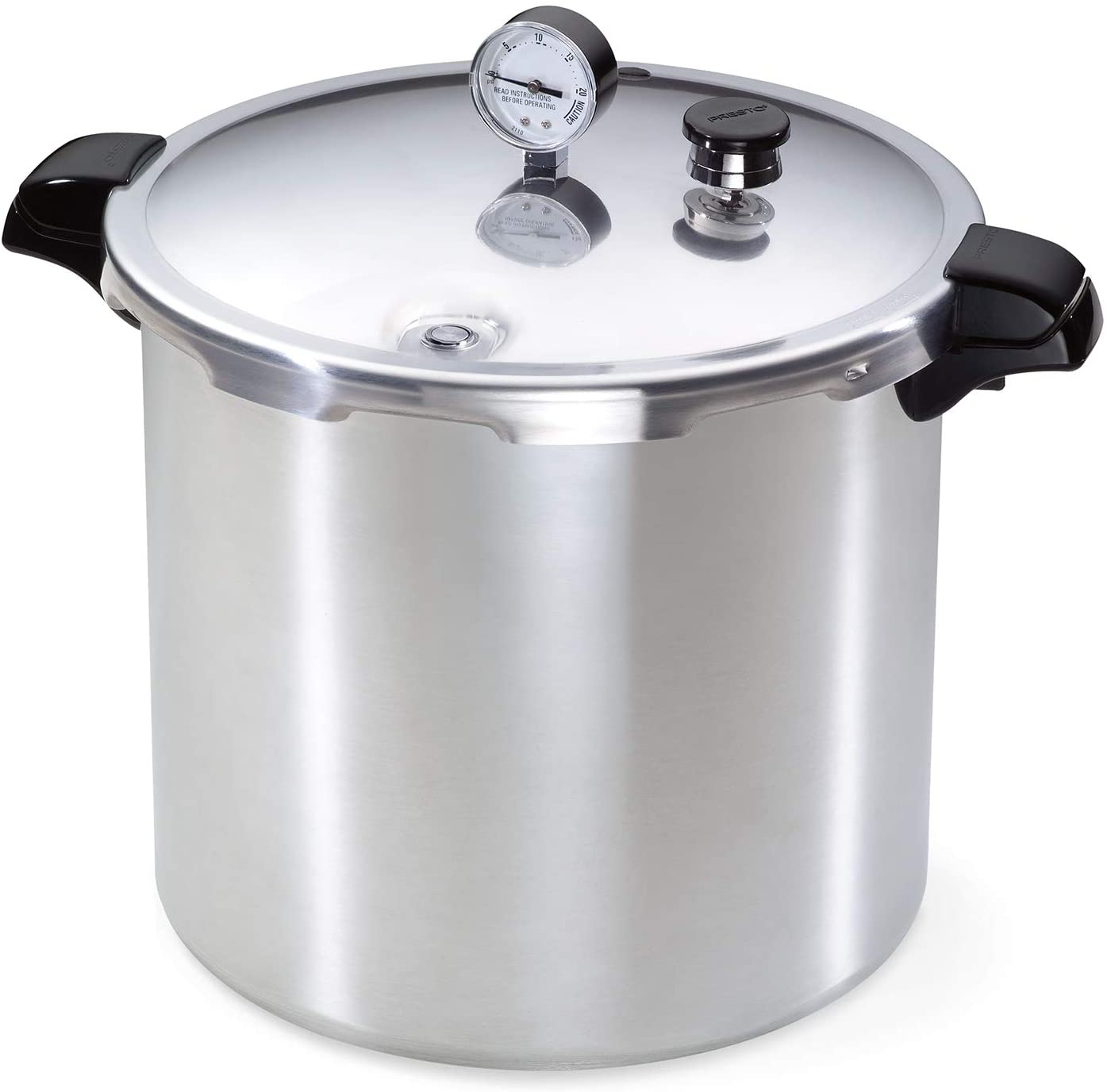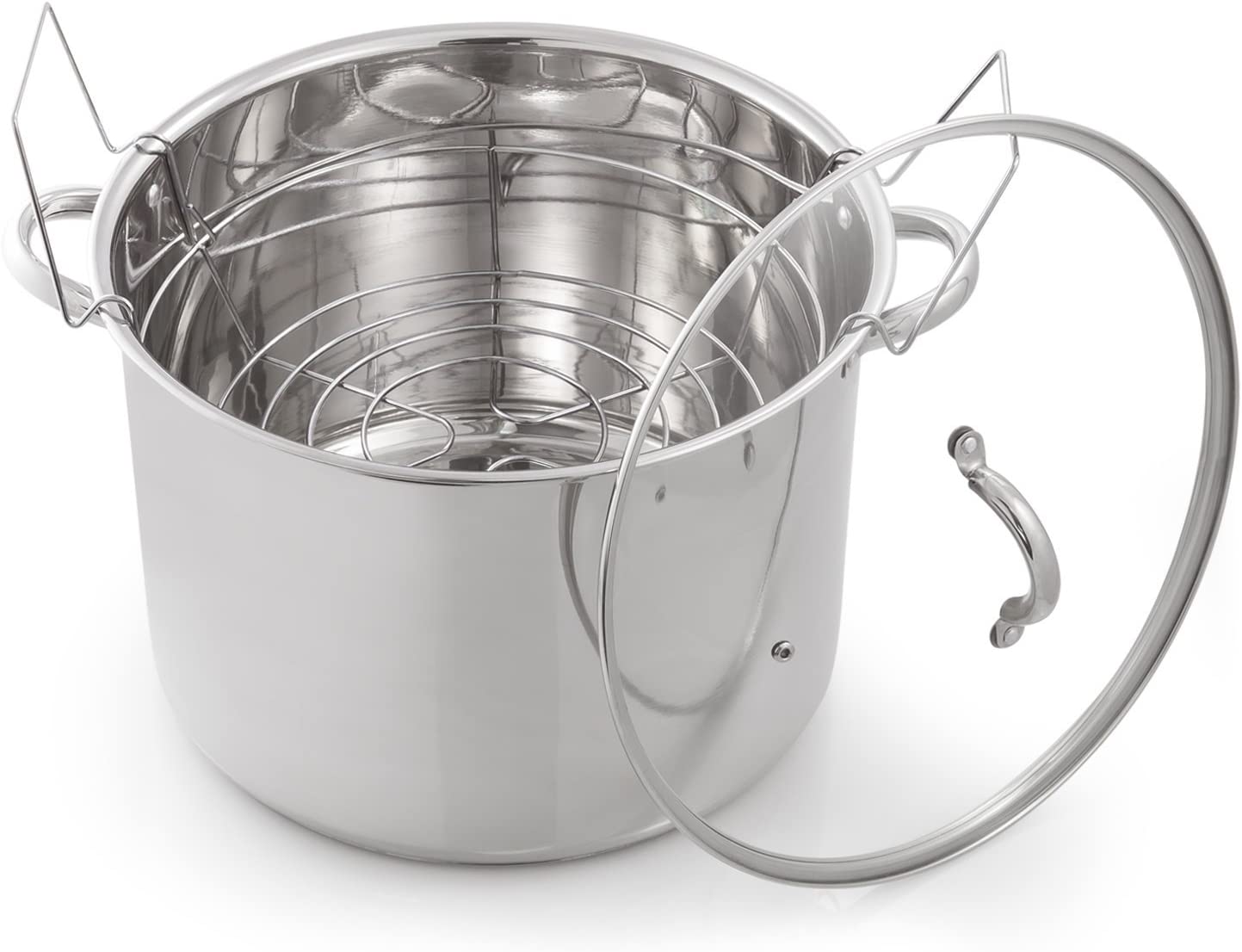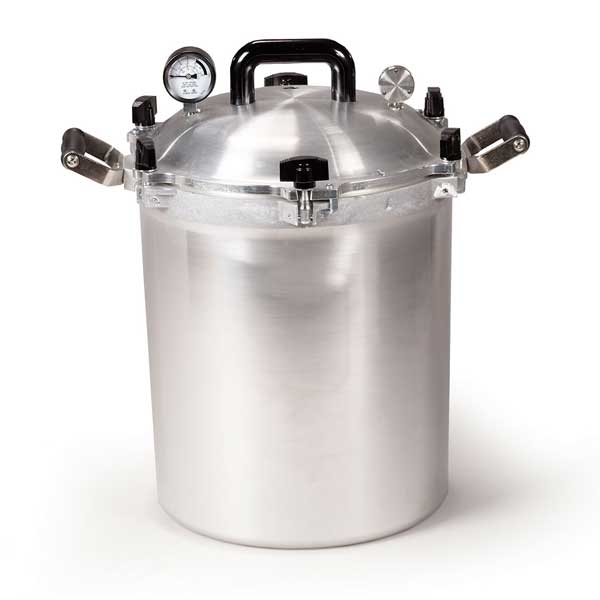The Best Pressure Canners for Your Money
If you find yourself throwing out a lot of produce, or you grow your own vegetables and have too many to actually use, pressure canning could be for you.
Popular with homesteaders, backyard gardeners and doomsday preppers, pressure canning is a food preservation method that uses steam and vacuum sealing to extend the shelf life of fruits, vegetables and even meat and fish. It uses special mason jars that can withstand the heat and special lids that provide an airtight seal.
Although the USDA doesn’t give exact expiration dates, food that has been canned properly and maintains an unbroken seal can last for years, unspoiled. Quality can diminish after the first year, however, but it's perfectly safe to eat after that. Some people, like homesteaders, will probably consume the food before that mark; for others, like preppers, the taste won’t matter as much if it's an emergency situation and all they're trying to do is survive.
Pressure Canner Buying Guide
Here are some factors to keep in mind as you shop for a pressure canner:
• Capacity. Pressure canning is often done in big batches, so the number of jars that fit in a single canner is important. You’ll need to consider the pressure canner’s capacity, both in diameter and height, and choose one that best matches both your stove and your needs in terms of how frequently you plan to can foods.
Using average-sized Mason jars, a 25-quart canner fits roughly 19 pint-sized jars (16 ounces). This is measured using the diameter of the pot and its stacking capacity — that is, whether you can use a second rack to place additional jars.
In addition to the canner’s capacity, if your stove is small, a pot that’s too wide might not fit properly or may heat up slowly. Also, flat-top stoves (also known as smooth top) can be affected by a big canner, since the heat distributed along the entire pot will heat up the area outside the burner. If the top of the stove is glass, you’ll need to think about the weight of the pot itself and the jars you intend to put in it — and do your best to place it gently to avoid cracking your stovetop.
• Material. Most pressure canners are made of either aluminum or stainless steel, which each has its respective advantages and disadvantages.
Aluminum, the most common canner material, is lightweight and an excellent heat conductor, so it’ll heat up evenly. However, aluminum is not extremely strong and can easily dent with falls or hard hits. Considering the fact that pressure canning depends on a tight seal, you should be very careful not to compromise that seal by denting the lid.
Stainless steel is much stronger than aluminum, but it’s also that much heavier. It’s not as good at conducting heat, but if you have an induction stove — which only works with magnetic materials — then it’ll probably be the best choice. However, some aluminum products nowadays, like our Editor’s Pick, have flat steel bottoms to make them compatible with induction stoves as well.
• Gauge. There are two ways to monitor and control the pressure on your pressure canner.
One is the classic dial gauge. It measures the pressure inside the pot, which you can adjust by increasing or decreasing the heat on the burner. This method can provide more precise temperature control, giving the user increments of 1 or even 0.5 pounds per square inch (psi). But tweaking the burner knob to create the ideal pressure can prove hard to do, and there are more possibilities of making mistakes.
The other method is the weighted gauge, which you place on top of the pot. This gauge controls the pressure and keeps it at a specific measurement of 5, 10 or 15 psi. Although the user has less control over the pressure (you only have those three options), the pressure is kept at exact and consistent levels.
This gauge starts jiggling to let out steam, and you’ll need to make sure it’s jiggling and letting out steam at a consistent rate. Note that you’ll only have to check this at the beginning of the process; it’s fairly hands-off afterward.
The biggest downside to the weighted method is those big gaps in pressure increases. If you live 1,000 feet or more above sea level, you’ll need higher pressure than average, but not necessarily a whopping 5 psi more. Sometimes, you will only need an increase of 0.5 to 1 psi. Cooking the food at much higher pressure won’t spoil it but can affect taste and texture — possibly making vegetables mushy, for example.
Water Bath Canning vs. Pressure Canning
There are two main canning methods: water bath and pressure canning. While the processes are similar, there are significant differences in terms of the types of foods you can preserve.
In water bath canning, you fill the pot almost entirely and submerge the jars, and the lid on the canning pot doesn’t seal completely. As the water reaches its boiling point of 212°F, it sterilizes the jars and the food inside. This method is good enough for high-acid foods like berries and tomatoes because the acidity itself helps prevent the formation of harmful toxins.
Pressure canners, on the other hand, use steam, which can reach higher temperatures of about 240°F. You only fill pressure canners about one-fourth or one-third of the way with water. The lids seal shut and, as the temperature rises, steam forms inside the pot. Thanks to extra heat provided by steam, pressure canning is effective for low-acid foods like meat and fish, which need extra help to prevent spoilage.
Do note that you can use pressure canners with high-acid foods, but they are generally more expensive than water bath canners. While pressure canners often cost over $200 and sometimes go much higher, water bath canners are available for less than $50.
How to Pressure Can
A certified pressure canner with an airtight seal and a steam valve is essential to pressure can. You’ll also need dedicated jars and lids approved for canning by the National Center for Home Food Preservation (NCHFP), such as Ball branded pint-sized jars.
The first step is to make sure that what you’re canning is safe. You can look up research-backed home canning recipes from the NCHFP or the U.S. Department of Agriculture to know which foods are safe to can and how exactly you should do it. Every step mentioned here on out will depend on the specific food, the recipe and the instructions given by those institutions.
To start, fill the canner about one-fourth of the way with water. Let it heat up and place the included canning rack on the bottom. Be sure to use the rack — placing the jars directly on the bottom of the pot could damage the seal and the jars themselves due to direct contact with the heat.
Next, place the jars inside the canner as it heats up so they warm up. Once warm, fill the jars with food and water, leaving about an inch of space between the content and the edge. Move it around a bit to make sure there are no air bubbles. Put the lids on and tighten the metal fasteners lightly, using only your fingers, and place them inside the canner.
When the canner is full, close it and seal it. Let it sit until you see steam coming out; then, let it steam for about 10 minutes. After that, place the gauge, whether dial or weighted, on top of the valve. Adjust the heat to get the desired pressure. If the gauge is weighted, just choose the adequate psi, and make sure it jiggles three to four times a minute — if it jiggles non-stop, make sure the jiggle is consistent.
Once you’re sure the pressure is correct, leave it for the amount of time the recipe calls for. When it’s done, take the jars out and let them cool down. Note that if one of the seals has broken, you have up to 24 hours to attempt to can it again or refrigerate it and use it within the next few days.
Reviewing the Best Pressure Canners of 2023
1. Best overall: All American 925 Aluminum Pressure Canner
List Price: $469.95
Check on Amazon | Check on Walmart
Every All American canner is made with the same design and quality materials. One of their most prominent features is the “metal to metal” seal, eliminating the need for a rubber gasket. This means no maintenance or replacements, as the metal seal will last throughout the pot’s lifetime. It’s important to note, however, that the edges of the pot and lid must be treated carefully to not disrupt that seal. Users shouldn’t hit the edges with metal utensils, for example, and should avoid dropping them.
All of the brand’s canners use the weighted gauge method for maximum precision. A single weight with three different sides (5, 10 and 15 psi) is included, along with two racks (one for the bottom and the other for a second layer of jars) and a recipe book. It does come with a dial gauge, but it’s just meant to indicate the pressure, not adjust it.
There are a couple of drawbacks to this pressure canner. For instance, All American’s line-up can’t be used with induction stoves because they are entirely made of aluminum. (This is an issue you’ll find with most products of this quality and size.) They’re not recommended for glass-top stoves either because of their weight — for example, this particular model is about 18 pounds when empty. Finally, the brand’s warranty is very short at only one year, although hopefully, you’ll never need it, as All American canners are known for their durability.
Pros
- Constructed from durable, high-grade cast aluminum
- Features a metal seal, reducing maintenance needs
- Includes a recipe book for canning inspiration
Cons
- Not compatible with induction stoves
- Fairly pricy at over $400
2. Editor’s pick: Presto 01784 Induction Pressure Canner
List Price: $175.99
Check on Amazon | Check on Walmart
Even though it makes some of the lowest-priced pressure canners on the market, the Presto brand has proven itself more than capable. The 01784 model, which sells for under $200 (and is sometimes on sale for about $150), is a perfect example. It performs just as well as some models that cost twice as much, and it has an induction-compatible stainless steel bottom that makes it very versatile.
The rest of the Presto 01784 is made of aluminum, but unlike the All American, it seals with a rubber gasket. This can be seen as a downside since rubber tends to degrade, but testimonials say it holds up quite well throughout the years, provided you take good care of it. Also, not all companies will have the top-notch machining necessary to provide a metal-to-metal seal. As an added bonus, Presto has a 12-year warranty, which is impressive considering that the leading brand, All American, offers only one year.
With a 23-quart capacity and measuring about 17 inches in height, it can fit 20 pint-sized jars. However, while you can double stack on the Presto 01784, you’ll need to buy the second rack separately. You’ll also need additional weights for 5 and 10 psi because the included one is only 15, which is too high for most foods — it’s safe but can lead to mushy veggies, for example. Buying these accessories can bring the overall cost closer to $200, but the initial set-up is enough to get started on your pressure canning journey.
Pros
- Compatible with induction stoves
- Impressive 12-year warranty for long-term use
- Great value for a low price
Cons
- Must purchase a second rack separately
- May need additional weights for versatility
3. Best for low prices: McSunley Stainless Steel Water Bath Canner
List Price: $57.78
Check on Amazon | Check on Walmart
Pressure canners aren't cheap, and the least expensive model will still set you back about $100. Water bath canners, on the other hand, provide a more affordable canning alternative that’s perfect if you’re just getting started and are unsure if this is something you’ll do long-term.
Water bath canning uses boiling water, which can’t reach the high temperatures the steam in pressure canners does. So water bath canners are best used for foods with enough acid to prevent harmful toxins from forming, such as tomatoes, apples, pickles and berries. You can’t preserve any type of meat or fish in a water bath canner.
The McSunley water bath canner is a really good model, especially given its price of less than $60. It’s constructed entirely of stainless steel, which gives it major durability. (While stainless steel doesn’t conduct heat as well as aluminum, it’s not as big of a drawback in water bath canning since the water helps conduct the heat.) It comes with a heavy-duty rack that you can remove easily, even with the nine pint-sized jars it’s designed to hold.
Although you can do water bath canning with almost any regular pot that’s big enough, the McSunley’s size, material, heavy-duty rack and 10-year warranty can make it much easier to get started.
Pros
- Very affordably priced model
- Ideal for canning foods with high acidity
- Impressive 10-year warranty
Cons
- Can't reach the temperature of a pressure canner
- Can’t preserve low-acid foods such as meat
4. Best for big batches: All American 941 Aluminum Pressure Canner
List Price: $649.95
Check on Amazon | Check on Walmart
As mentioned about our Best Overall pressure canner, the All American brand is one of the leading choices in pressure canners. The company makes essentially the same model in sizes ranging from 10.5 quarts all the way up to 41. The 41-quart model is our recommended pick if you want to make big batches of canned goods and fill up your cupboard as fast as possible.
Like the 25-quart model, the 41-quart All American 941 features a metal-to-metal seal, uses a weighted gauge that can be switched between 5, 10 and 15 psi and is made from American-made high-grade cast aluminum. The difference here is that the 941 is enormous and can fit a whopping 32 pint-sized jars at a time.
This size can also be a drawback, however, depending on your stove. All American does not recommend using any of its products on a glass top stove, and that is especially true with this one, which weighs 33 pounds when empty and easily surpasses 50 pounds when completely full.
Finally, this model is quite costly, generally selling for about $600, although it can sometimes be found on sale for about $50 less. (Side note: It's also occasionally been difficult to find in stock, period, in 2020 and 2021.) If you want something similarly big but for much less money, check out models such as the Lehman’s 50-quart stainless steel water bath canner, though you won’t be able to can meats, fish and other low-acid foods.
Pros
- Very large capacity for bulk canning
- Easy to adjust the pressure
- Metal-to-metal seal for long-term use
Cons
- Very expensive compared to other models
- Heavy weight makes it difficult to move
5. Best digital pressure canner: Presto Precise 02144 Digital Pressure Canner
List Price: $329.99
Check on Amazon | Check on Walmart
Though pressure canning is not complicated, it can be somewhat annoying to set up. The Presto Precise was designed to make it much, much less so.
Advertised as the first and only digital canner approved by the USDA, the Presto Precise guides you through the canning process, alerting you when it’s time for the next step, all while regulating temperature and pressure automatically.
This is probably its most important feature. Regulating pressure manually with a dial gauge is both tedious and often imprecise, and it requires a lot of attention at the beginning of the process. This automation also means that there’s no need to adjust for altitude. The machine sets the pressure at the exact level it should be instead of augmenting it by large 5 psi increments like weighted gauges.
The Presto Precise is electric, so you won’t need your stove and can even use it away from the kitchen. It’s quite big, significantly larger than an average Instant Pot, so being able to move it out of the way is a nice perk.
Pros
- Electric design doesn't require a stove
- Automated pressure and temperature adjustments ensure precision
- Very easy and convenient to use
Cons
- Must readjust silicone ring on each use
- Still requires monitoring
Why Trust Us
Our commitment to customers begins with a carefully curated product selection process, ensuring we provide high-quality and reliable options. We meticulously vet each pressure canner, analyzing quantitative aspects, such as star ratings and review count, and qualitative factors, including review content and product features. Our dedicated team of bargain hunters consistently prioritizes your budget by meticulously scouring the market and identifying the best pressure canners available without ever compromising on quality or performance. Our panel focuses on presenting the pros and cons of each pressure canner and converting technical specs into understandable insights. We aim to help you achieve the most efficient and effective pressure canning experience possible with high-quality products.
More From Money:
The Best Instant Pots and Pressure Cookers for Your Money, According to Food Bloggers





